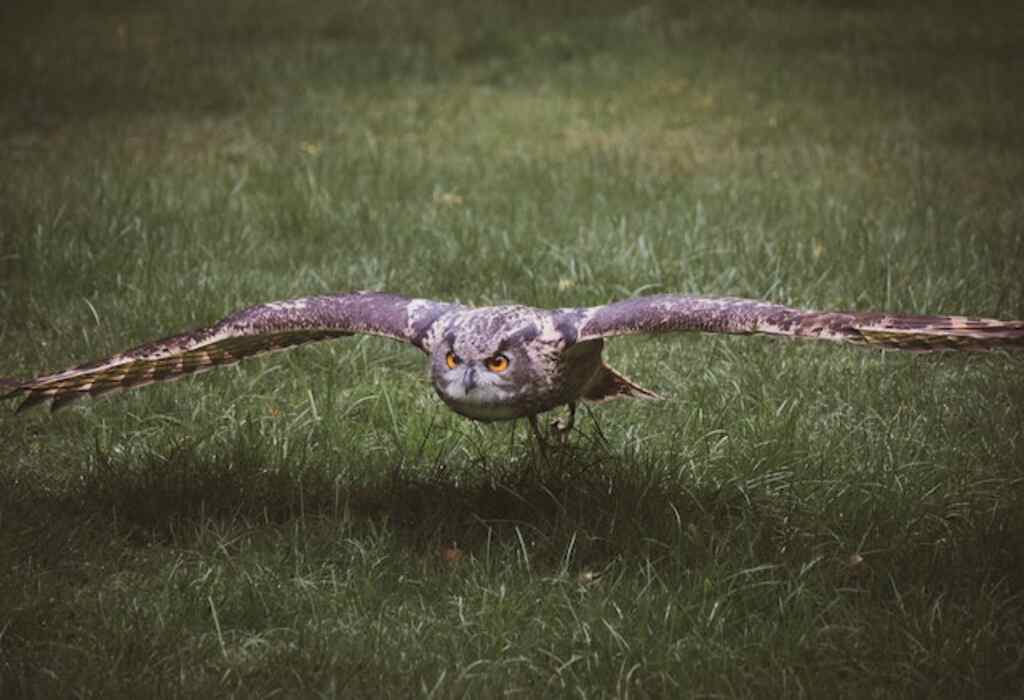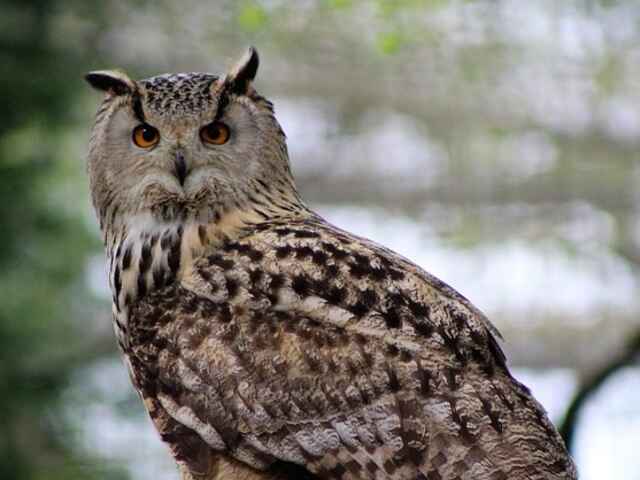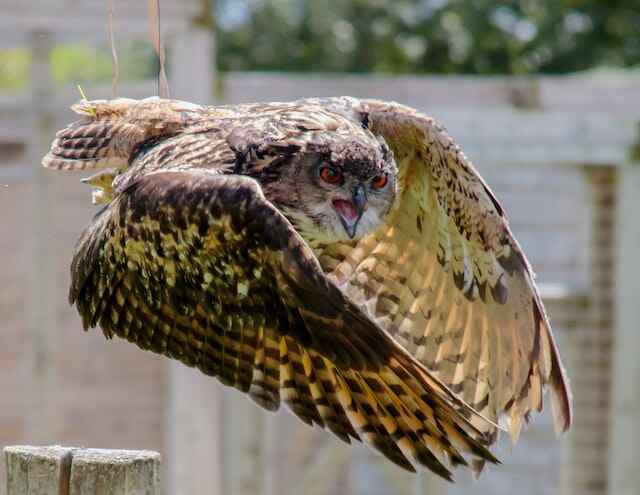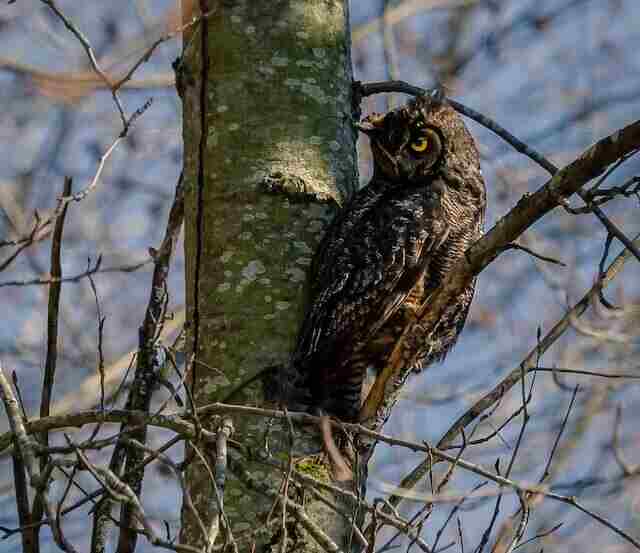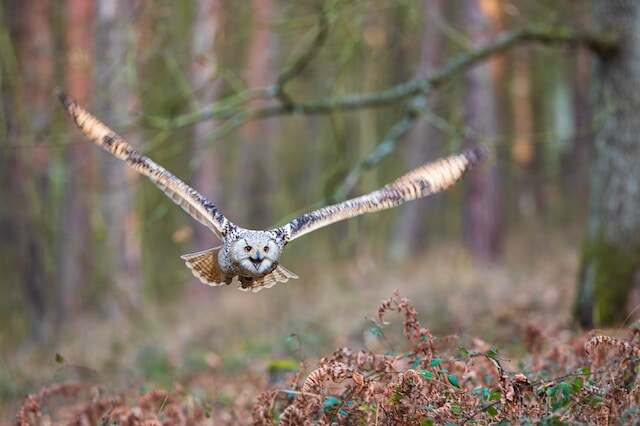Meow or never, the question we’ve all been asking: Do owls eat cats? The answer is yes, but before you start keeping your feline friend locked indoors, let’s delve into the fascinating world of owls and their dietary habits.
From the great horned owl’s powerful grip to the barn owl’s stealthy approach, we’ll explore the reasons behind this unlikely predator-prey relationship. Get ready to hoot and holler, because this article is a real hoot!
Table of Contents
The Wondrous and Mysterious World of Owls
Owls have been revered for centuries as symbols of wisdom, intelligence, and mystery. They have inspired countless myths, legends, and stories throughout history. These nocturnal birds of prey are known for their large eyes, silent flight, and powerful talons that make them formidable hunters.
Owls belong to the order Strigiformes and are found in a variety of habitats around the world. There are over 200 species of owls, ranging in size from the tiny elf owl (5 inches tall) to the giant eagle owl (3 feet tall).
Most owls feed on small mammals such as rodents, rabbits, and bats. However, they also eat insects, fish, reptiles, and even other birds.
The Owl’s Diet: More Than Meets The Eye
At first glance, it may seem like owls have a simple diet consisting only of small prey animals. However, their hunting strategies are anything but simple. Owls have incredible senses that allow them to locate prey in complete darkness.
Their large eyes are adapted to low light levels, which help them see even at night. In addition to their exceptional vision, owls also use their acute sense of hearing to locate prey.
They can detect sounds as quiet as a mouse rustling in leaves from up to 100 feet away! Once they’ve located their target using either sight or sound (or both), they swoop down with lightning speed and grab it with their sharp talons.
Can Owls Eat Cats?
The question on everyone’s mind when it comes to owls’ diet is whether or not they can eat cats. It’s a fascinating question because most people don’t imagine cats as being part of an owl’s prey.
However, it’s important to remember that owls are opportunistic hunters and will eat whatever prey is available to them. So, can owls eat cats? The answer is yes, some species of owls have been known to prey on cats.
However, this doesn’t mean that all owls will target cats as their prey. Factors such as the size of the owl, the size of the cat, and the habitat where they both live will determine if an owl would consider a cat as a potential meal.
In the next section, we’ll explore this topic in more detail and look at some documented cases where owls have attacked cats.
When Do Owls Attack Cats?
Owls usually attack cats during their active hunting hours, which are typically at night. The exact timing can vary depending on the species of owl and the location, but it’s common for owls to hunt at dusk and dawn.
Additionally, owls are more likely to attack cats during the breeding season or when they are protecting their nests.
It’s important to keep cats indoors during these times to prevent them from becoming prey to these nocturnal predators.
Why Do Owls Attack Cats?
Owls may attack cats if they feel threatened or if they are hungry and see the cat as prey. Some owl species, such as great horned owls, are known to hunt and kill larger animals than themselves, including cats.
However, such attacks are relatively rare and usually occur at night, when cats are more vulnerable. In most cases, owls are unlikely to attack cats unless they are provoked or feel that their territory is being threatened.
But Aren’t Cats Too Heavy?
It depends on the size of the owl and the cat. While most species of owls are not strong enough to carry off adult cats, some larger owl species such as the Eurasian eagle owl and the great horned owl have been known to prey on cats.
However, these instances are relatively rare and cats are not a primary food source for owls. In general, most owls prefer smaller prey such as rodents, insects, and small mammals.
| Information | Description |
|---|---|
| Owl size | The ability of an owl to carry a cat depends on the size of the owl. |
| Cat size | The ability of an owl to carry a cat depends on the size of the cat. |
| Larger owl species | Some larger owl species such as the Eurasian eagle owl and the great horned owl have been known to prey on cats. |
| Rarity of occurrence | Instances of owls preying on cats are relatively rare. |
| Primary food source | Cats are not a primary food source for owls. |
| Preferred prey | Most owls prefer smaller prey such as rodents, insects, and small mammals. |
What Makes An Owl Decide To Attack A Cat?
There are several factors that may influence an owl’s decision to attack a cat, including hunger, territorial defense, protection of young owls, or mistaking the cat for prey.
Additionally, some owl species, such as Great Horned Owls, are known to be more aggressive hunters and may be more likely to attack cats or other prey.
However, it’s important to note that owls generally prefer smaller prey, such as rodents, birds, and insects, and attacks on cats are relatively rare.
The Diet of Owls
Belonging to the Strigiformes order, owls are predatory birds. They are known for their exceptional hunting skills and their nocturnal lifestyle. Owls have a diverse diet, and what they eat largely depends on their species, location, and availability of prey.
What Do Owls Typically Eat?
The diet of owls is incredibly diverse. Some species prefer to hunt small mammals such as rodents, shrews, and rabbits.
Other species feed on insects, frogs, lizards, snakes, and fish. Some owls also hunt other birds like pigeons or doves.
One interesting feature about owl’s diet is that they can swallow their prey whole because they lack teeth necessary for biting and chewing food.
They use their strong beaks to tear apart the flesh of their prey into small pieces.
| Prey | Description |
|---|---|
| Small mammals | Some species prefer to hunt small mammals such as rodents, shrews, and rabbits. |
| Insects, frogs, lizards, snakes, and fish | Other species feed on insects, frogs, lizards, snakes, and fish. |
| Other birds | Some owls also hunt other birds like pigeons or doves. |
How Do They Hunt Their Prey?
Owls are skilled hunters who use a combination of stealth and power to catch their prey. In general, owls have excellent eyesight that allows them to see in low light conditions; which makes it easy for them to spot small animals from a distance.
Once an owl has spotted its prey from afar or by hearing it move nearby using its exceptional hearing capability; it swoops down silently towards its target at incredible speed with precision accuracy before snatching it up with its talons.
| Hunting Method | Description |
|---|---|
| Excellent eyesight | Owls have excellent eyesight that allows them to see in low light conditions; which makes it easy for them to spot small animals from a distance. |
| Exceptional hearing | Owls can also hear the slightest movements of their prey, which helps them locate their targets. |
| Silent swoop | Once an owl has spotted its prey, it swoops down silently towards its target at incredible speed with precision accuracy before snatching it up with its talons. |
Why Are They Able To Digest Bones And Fur?
Owls have a unique digestive system that enables them to digest bones along with fur or feathers; this process separates the indigestible parts which make up pellets after digestion from the rest of the digested food, which is then excreted out as waste.
The digestion process involves breaking down food in the stomach aided by powerful digestive enzymes, while undigested parts remain in a specialized part of the stomach known as the gizzard; where they are compacted and formed into pellets.
Owls have a diverse diet that varies depending on their species and location. They make use of their exceptional hunting skills, combined with exceptional eyesight and hearing, to catch their prey.
Their unique digestive system allows them to digest bones and fur; which is an excellent adaptation for consuming a wide variety of prey.
| Adaptation | Description |
|---|---|
| Unique digestive system | Owls have a unique digestive system that enables them to digest bones along with fur or feathers. |
| Pellet formation | The digestion process involves breaking down food in the stomach aided by powerful digestive enzymes, while undigested parts remain in a specialized part of the stomach known as the gizzard; where they are compacted and formed into pellets. |
| Wide variety of prey | Owls’ unique digestive system allows them to consume a wide variety of prey, including those with indigestible parts such as bones and fur. |
Can Owls Eat Cats?
Owls are known for being skilled hunters and feed on a variety of prey. While their diet consists primarily of small mammals like mice, rats, and rabbits, some species have been known to target larger prey like cats.
The answer to whether owls can eat cats is yes, but it’s important to understand the factors that determine whether an owl will target a cat as prey. One factor is the size of the owl relative to the cat.
Larger species of owls like Great Horned Owls and Eagle Owls are more likely to attack cats due to their size and strength. Smaller species like Screech Owls are less likely to target a cat, as they prefer smaller prey.
Another factor is the habitat in which the owl lives. Owls that live in urban areas are more likely to encounter domestic cats as potential prey than those that live in rural areas, where wild animals are more abundant.
There have been documented cases where owls have attacked and killed domestic cats. One such case occurred in 2016 when an Owl attacked a family’s pet cat through an open window near Los Angeles.
The owner heard her cat screeching outside before discovering it was being attacked by an Owl. Unfortunately, despite efforts from veterinarians, the cat did not survive its injuries.
Another example is from 2018 when a family’s pet Persian Cat was snatched by a Great Horned Owl from their backyard in Florida.
Despite searching for days with no luck finding their beloved pet, they eventually found remains believed to be those of their missing feline friend, indicating consumption by the predator bird.
It’s important for pet owners to take precautions if they live in an area where owls are known predators or if they suspect there may be one nearby.
Keeping pets indoors during times when owls may be hunting (dusk or dawn) is strongly recommended, as well as keeping an eye on them while they are outside.
Do All Owls Like To Eat Cats?
No, not all owls like to eat cats or find them to be a preferred food source. Owls are opportunistic predators and will typically prey on whatever is most abundant and easily accessible in their habitat, such as rodents, birds, or insects.
In some cases, when food is scarce, larger owls may consider attacking cats as a potential food source. However, this is not a common occurrence and most owls do not view cats as a preferred prey item.
Owl-Cat Interactions
What Happens When an Owl Attacks a Cat?
Owls can attack cats in a number of ways. Typically, they will swoop down from above and grab the cat with their talons. They may also use their beaks to bite the cat’s neck or head in order to kill it quickly.
If the cat is too large for the owl to carry away, it may be dragged into nearby bushes or trees to be consumed. When an owl attacks a cat, it can be a traumatic experience for both the pet and its owner.
Cats are usually caught completely off guard and have no way of defending themselves against these powerful birds of prey. Owners who witness such an attack may feel helpless as they watch their beloved pet being carried away.
| Attack Method | Description |
|---|---|
| Swoop down from above | Owls will typically swoop down from above and grab the cat with their talons. |
| Use beaks to bite | Owls may use their beaks to bite the cat’s neck or head in order to kill it quickly. |
| Drag into nearby bushes or trees | If the cat is too large for the owl to carry away, it may be dragged into nearby bushes or trees to be consumed. |
How Can Pet Owners Prevent Owl Attacks on Their Cats?
To prevent owl attacks on cats, pet owners should take steps such as keeping their cats indoors at night, especially during times when owls are most active (i.e., dawn and dusk).
Additionally, any outdoor areas where cats spend time should be well-lit so that owls are less likely to approach.
Pet owners who live in areas with high owl populations should also consider building outdoor enclosures for their cats to play in during the daytime hours.
These enclosures should be covered with netting or other materials that will prevent owls from gaining access.
| Prevention Method | Description |
|---|---|
| Keep cats indoors at night | Pet owners should keep their cats indoors at night, especially during times when owls are most active (i.e., dawn and dusk). |
| Well-lit outdoor areas | Any outdoor areas where cats spend time should be well-lit so that owls are less likely to approach. |
| Build outdoor enclosures | Pet owners who live in areas with high owl populations should consider building outdoor enclosures for their cats to play in during the daytime hours. These enclosures should be covered with netting or other materials that will prevent owls from gaining access. |
Do Domestic Cats Pose a Threat to Owls?
While domestic cats are not typically considered a threat to owls, there have been instances where cats have attacked and killed these birds of prey. This is particularly true for younger owlets that have fallen out of nests and are unable to defend themselves.
Because owls play an important role in maintaining healthy ecosystems by controlling rodent populations, it is important for pet owners to keep their cats under control and prevent them from preying on these creatures.
This can be done by keeping cats indoors or supervising their outdoor activities closely.
Summary of the Main Points
In this article, we’ve explored the fascinating topic of whether owls can eat cats. We learned that owls have a varied diet and are skilled hunters, with some species able to consume prey much larger than themselves.
We also discovered that while rare, there have been documented cases of owls attacking and consuming cats. However, whether an owl will target a cat depends on several factors, such as prey availability and size.
When it comes to owl-cat interactions, we found out that these attacks can leave devastating injuries or even result in the death of the cat.
Therefore, pet owners need to take necessary measures to avoid such encounters by keeping their cats indoors at night or keeping an eye on them when outside.
Final Thoughts
The question of whether owls can eat cats is not just a matter of scientific inquiry but also highlights our complex relationship with nature. While it’s easy to condemn predatory behavior as cruel or ruthless, it’s important to remember that predators play a crucial role in maintaining ecological balance.
In this light, domestication has created a delicate balance between humans and animals, where pets are seen more like family members than wild animals.
However, this comes with its own set of responsibilities such as ensuring their safety even if it means curbing natural instincts.
Overall, while evidence suggests that owl attacks on cats are infrequent, pet owners should take necessary precautions when living in areas with large owl populations.
By respecting nature’s delicate balance and being responsible pet owners, we can create a world where both pets and wildlife coexist peacefully.
Related Post: Why do Owls Screech: The Fascinating Mystery Unveiled!

